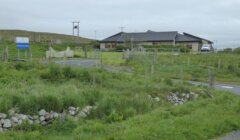Council / Cullivoe road project to move to next stage after approval from councillors
Proposals involving linking to Dalsetter by road to stay on the table for now despite call to remove them
PLANS for a new road in Cullivoe have taken a further step forward after councillors gave the green light for six options to go forward for further evaluation.
These options range in capital cost £2.1 million to £7.8 million – with work potentially starting in 2021/22.
At a meeting of the full Shetland Islands Council on Wednesday central member Moraig Lyall suggested two options involving a new road going over the hill to Dalsetter should be discounted to speed up the process.
However, her amendment lost by 19 votes to three.
The upgrade of the B9082 from Gutcher to Cullivoe was made a priority road project late last year as it is “no longer considered fit for purpose” due to the number of HGV vehicles using the road.
It is a vital link road for the fishing and aquaculture industries which use the Cullivoe pier.
It is thought that the development and construction period could last up to six years.
In line with the council’s medium term financial plan and borrowing policy, the costs would be funded by borrowing and it would add to the council’s external debt.
A total of six options have been distilled into a shortlist, including a ‘do minimum’ measure featuring patching and surface dressing, while there is also a proposal to construct a new single-track road with passing places on a new alignment.
Another option would see the reconstruction of the Dalsetter to Gutcher hill road with passing places, widening it to 3.3 metres.
An ‘upper intermediate’ option includes the construction of a new two-lane road, as well as a new piece of single-track road with passing places on a new alignment. This would “future proof” a connection to a potential fixed link.
Other options, described as “maximum” in scope, include the construction of a new two-lane road on a new alignment and, and a new two-lane road on a new alignment over the hill from Dalsetter to Cullivoe.
Become a member of Shetland News
Lyall claimed, however, that the two options relating to Dalsetter had major flaws.
She said they would result in extra maintenance for highway staff, did not take into account a future fixed link and had uncertainty over cost.
But asset and network team leader in the roads department Neil Hutcheson said he felt dismissing the options at this stage would be “premature”.
“I think the issue is that it’s quite early in the whole business case process,” he said.
Hutcheson added that the Dalsetter options would present the shortest travel time for traffic heading south through Yell.
North Isles member Duncan Anderson, meanwhile, asked whether the six-year estimate for completion was a worst case scenario.
“Six years will be a long time for a community to wait,” he said.
A major factor in the time scale is the legal process and acquisition, according to assets, commissioning and procurement manager Robert Sinclair.
Hutcheson added that the council was currently in the process of trying to bring forward surveying and minor ground investigations.
“Hopefully that will help so we can bring things a year or two forward,” he said.
Shetland Central member Davie Sandison, meanwhile, asked if the project was being taken to a national level in terms of funding.
SIC chief executive Maggie Sandison confirmed the council will seek external funding on top of its usual roads grant.
She also suggested that there could be opportunities for this kind of project in the UK Government’s infrastructure-led approach to the recovery and renewal from the coronavirus pandemic.
Council leader Steven Coutts also said there was a “national significance” to the aquaculture industry using the Cullivoe Pier.
Environment and transport committee chairman Ryan Thomson said it was an “important step towards what is an essential project” for Shetland and moved the recommendations.
He described the chance to future proof a connection to a possible fixed link as a “once in a lifetime opportunity”.
Lyall’s amendment was debated by members but the discussion was largely on the side of keeping all six options on the table at this time.
Council leader Steven Coutts said it would be “very, very unwise to remove options at this stage” as it would not have an effect the timeline of the project.
Lerwick member John Fraser echoed his comments, saying: “I feel there’s a duty of care for the local authority to consider all potential options.”
South mainland member George Smith noted that a road in Yell was some distance away from his own ward, but said the project was significant for the whole of Shetland.
“This is the most important piece of road development that we have for our economic wellbeing,” he said.
North mainland councillor Alastair Cooper, meanwhile, said the Dalsetter options “tick a big box” for him in terms of carbon footprint as it is a shorter route.
With more fish landings potentially coming into Shetland post-Brexit and extra lorries likely to use the road, this was all the more important, he added.
Only three councillors voted in favour of the amendment to remove the Dalsetter options – proposer Moraig Lyall, Amanda Hawick and Ian Scott.
Councillors were told that the next report on the project should come before them in September.
Become a member of Shetland News
Shetland News is asking its readers to consider paying for membership to get additional perks:
- Removal of third-party ads;
- Bookmark posts to read later;
- Exclusive curated weekly newsletter;
- Hide membership messages;
- Comments open for discussion.
If you appreciate what we do and feel strongly about impartial local journalism, then please become a member of Shetland News by either making a single payment, or setting up a monthly, quarterly or yearly subscription.














































































